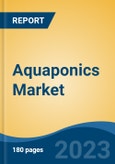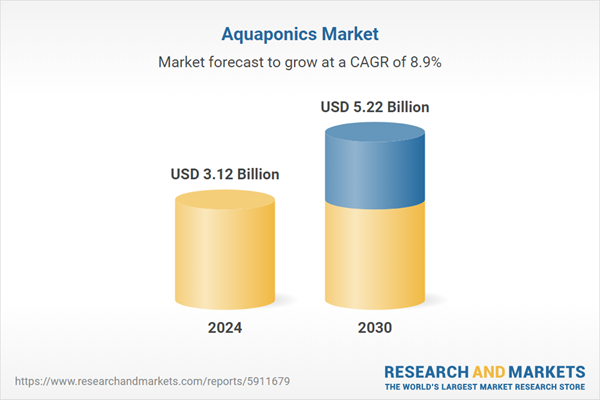Speak directly to the analyst to clarify any post sales queries you may have.
10% Free customizationThis report comes with 10% free customization, enabling you to add data that meets your specific business needs.
The nutrient-rich water generated from fish breeding serves as an excellent fertilizer for indoor plants. Simultaneously, the plants provide a freshwater habitat for the fish. Aquaponics is renowned for its ability to stimulate natural ecosystems, making it an environmentally friendly approach to food production. By promoting sustainability and yielding organic vegetables while significantly reducing waste, aquaponics offers an effective and eco-friendly solution for growing crops. This capability is expected to play a crucial role in driving the growth of the aquaponics market.
Furthermore, growing concerns over climate change, soil degradation, and water scarcity are accelerating the global adoption of aquaponics systems. Traditional agriculture often requires vast land areas and excessive water consumption, contributing to environmental strain. In contrast, aquaponics utilizes up to 90% less water and significantly less space, making it an ideal alternative for urban and arid regions. The closed-loop system not only minimizes resource wastage but also eliminates the need for synthetic fertilizers and pesticides, aligning with global trends toward sustainable and chemical-free farming practices. As a result, governments and private stakeholders are increasingly supporting aquaponics initiatives through research grants, subsidies, and policy incentives.
Key Market Drivers
Reduction in Arable Land Globally
The shrinking availability of arable land continues to be a pressing global concern. According to the Food and Agriculture Organization (FAO), the world has lost nearly one-third of its arable land over the past 40 years due to erosion, pollution, and unsustainable farming practices. Urbanization, desertification, and industrial development are further accelerating this loss. In densely populated and land-scarce regions, traditional farming is no longer feasible, creating a dire need for alternative cultivation methods. Aquaponics emerges as a promising solution, maximizing food production in minimal space while conserving vital natural resources.As arable land declines, food production systems are under increasing pressure to meet the nutritional needs of a growing global population, projected to surpass 9.7 billion by 2050. Aquaponics, with its compact design and resource efficiency, can be deployed in urban settings such as rooftops, basements, or warehouses, turning non-traditional spaces into food-producing zones. Unlike conventional farming, aquaponics systems do not depend on fertile soil, thus providing a resilient strategy to combat the negative effects of land degradation and urban sprawl on agriculture.
The integration of aquaculture and hydroponics in aquaponics systems allows for dual food production - fish and plants - within a single environment. Its closed-loop design utilizes fish waste as a natural fertilizer for plants, while the plants purify the water for the fish, resulting in minimal resource wastage. Notably, aquaponics uses up to 90% less water than traditional agriculture. This sustainable mechanism not only conserves water but also reduces reliance on chemical inputs, aligning with global trends favoring eco-conscious and organic food systems.
In addition to its environmental benefits, aquaponics supports food security and economic resilience. With nearly 60 million hectares of land degraded annually worldwide, the need for high-yield, low-footprint farming systems is more critical than ever. Aquaponics offers consistent year-round production, unaffected by changing climate or soil conditions, making it ideal for both urban dwellers and rural communities facing agricultural constraints. As awareness and innovation in this field grow, aquaponics is gaining traction as a sustainable, scalable solution to counteract the global reduction in arable land.
Key Market Challenges
High Cost of Initial Investments
The global demand for aquaponics, a sustainable method of raising both fish and vegetables, is likely to be negatively impacted by the high cost of initial investments. The setup of an aquaponic system involves substantial expenses, including that of purchasing or constructing the system, sourcing fish and plants, and ensuring a constant power supply for maintaining water temperature and air circulation. Additionally, the costs are not only financial but also temporal, as the system requires a significant initial time investment to learn, set up, and properly maintain.These costs can make the initial steps towards aquaponics daunting for potential adopters, particularly in developing nations where resources may be limited. This can result in a decreased demand for aquaponics on a global scale. However, it's important to note that while the initial investment may be high, the long-term benefits, such as reduced water usage, elimination of pesticides, and the potential for a closed-loop, self-sustaining system, can outweigh the startup costs. Therefore, initiatives that help reduce the upfront cost and learning curve of aquaponics could play a crucial role in driving its global adoption.
Moreover, the lack of widespread technical expertise and limited access to financing options further compound the challenge of high initial investment. Many small-scale farmers and entrepreneurs, particularly in low- and middle-income countries, find it difficult to secure loans or grants for innovative agricultural practices like aquaponics due to the perceived risks and lack of familiarity among financial institutions. To overcome this barrier, governments, NGOs, and private stakeholders need to collaborate on awareness programs, offer financial incentives, and support training initiatives. By bridging the financial and knowledge gaps, broader participation in aquaponics can be fostered across diverse economic segments.
Key Market Trends
Growing Popularity of Home-Based Aquaponics Systems
Aquaponics, an innovative method of cultivating plants and rearing fish in a symbiotic environment, has been gaining substantial traction in recent years, particularly in the realm of home-based systems. This trend is projected to significantly augment global demand for aquaponics. The reasons for this upswing in popularity are manifold. Firstly, home-based aquaponics systems offer an efficient solution for urban dwellers seeking to practice sustainable agriculture within limited spaces.Secondly, these systems, characterized by their water efficiency and minimal waste, align with increasing consumer awareness and commitment to environmental sustainability. They also present an opportunity for individuals to grow their food, ensuring it is fresh, organic, and free from harmful pesticides. Thirdly, the global COVID-19 pandemic has highlighted the vulnerabilities inherent in traditional food supply chains, bolstering interest in self-sufficiency, of which home-based aquaponics is an exemplar. As more people adopt these systems and propagate their advantages, the global demand for aquaponics is predicted to continue its upward trajectory in the foreseeable future.
In addition, the increasing availability of compact, affordable, and easy-to-install aquaponics kits is further driving the adoption of home-based systems. These kits often come with user-friendly manuals and digital monitoring tools, making them accessible even to beginners with limited agricultural knowledge. The rise of online communities and instructional content on platforms like YouTube and social media has also played a pivotal role in spreading awareness and boosting confidence among first-time users. As technological innovations continue to simplify system maintenance and improve yield efficiency, home-based aquaponics is likely to evolve from a niche hobby into a mainstream sustainable living practice.
Key Market Players
- Nelson and Pade Inc.
- Pentair Aquatic Eco-Systems, Inc.
- ECF Farm systems GmbH
- Backyard Aquaponics Pty Ltd.
- AquaCal AutoPilot, Inc.
- GrowUp Urban Farms Ltd.
- The aquaponic manufaktur GmbH
- NutraPonics Canada Corporation
- Aponic Ltd.
- Blueplanet Urban Agro Services Pvt Ltd.
Report Scope:
In this report, the Global Aquaponics Market has been segmented into the following categories, in addition to the industry trends which have also been detailed below:Aquaponics Market, By Equipment:
- Pumps & Valves
- Grow Lights
- Water Heaters
- Water Quality Testing
- Fish Purge Systems
- Aeration System
Aquaponics Market, By Method:
- Media Based
- Nutrient Film Technique [NFT]
- Deep-Water Culture
Aquaponics Market, By Application:
- Commercial
- Home food Method ion
- Education & Research
- Others
Aquaponics Market, By Region:
- North America
- United States
- Canada
- Mexico
- Europe
- France
- United Kingdom
- Italy
- Germany
- Spain
- Asia-Pacific
- China
- India
- Japan
- Australia
- South Korea
- South America
- Brazil
- Argentina
- Colombia
- Middle East & Africa
- South Africa
- Saudi Arabia
- UAE
Competitive Landscape
Company Profiles: Detailed analysis of the major companies present in the Global Aquaponics Market.Available Customizations:
With the given market data, the publisher offers customizations according to a company's specific needs. The following customization options are available for the report.Company Information
- Detailed analysis and profiling of additional market players (up to five).
Table of Contents
Companies Mentioned
- Nelson and Pade Inc.
- Pentair Aquatic Eco-Systems, Inc.
- ECF Farm systems GmbH
- Backyard Aquaponics Pty Ltd.
- AquaCal AutoPilot, Inc.
- GrowUp Urban Farms Ltd.
- The aquaponic manufaktur GmbH
- NutraPonics Canada Corporation
- Aponic Ltd.
- Blueplanet Urban Agro Services Pvt Ltd.
Table Information
| Report Attribute | Details |
|---|---|
| No. of Pages | 180 |
| Published | August 2025 |
| Forecast Period | 2024 - 2030 |
| Estimated Market Value ( USD | $ 3.12 Billion |
| Forecasted Market Value ( USD | $ 5.22 Billion |
| Compound Annual Growth Rate | 8.9% |
| Regions Covered | Global |
| No. of Companies Mentioned | 10 |









